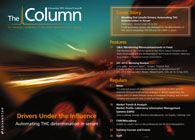Honeybee Foraging
Diesel exhaust fumes can rapidly degrade the floral odours used by honeybees (Apis melifera) to identify flowering plants, according to results published by scientists at the University of Southampton (Southampton, UK) in the journal Scientific Reports.1
Diesel exhaust fumes can rapidly degrade the floral odours used by honeybees (Apis melifera) to identify flowering plants, according to results published by scientists at the University of Southampton (Southampton, UK) in the journal Scientific Reports.1
Lead author Tracey A. Newman told The Column that she was initially interested in investigating the impact of airborne pollutants on human health, specifically the effects on the human nervous system. At the time interest was growing in the causes of decreasing populations of honeybees, so her colleague and mentor suggested that she partner up with ecologist Professor Guy Poppy, to investigate the impact of airborne pollutants on honeybees. Newman said: “The end result was that the two of us, in close collaboration with Dr Robbie Girling, a chemical ecologist, worked up a couple of different proposals that drew together our key skills – neuro-immunology and ecology – to enable us to explore the impact of diesel exhaust on the honeybee nervous system and the impact on the chemical environment that the honeybee has to operate within.”
The team composed a synthetic blend of eight compounds found in oil seed rape flowers (Brassica napus) that were known to induce strong behaviour in honeybees. The aroma blend was entered into a closed glass vessel with either “clean” or diesel exhaust contaminated air. The volatile abundance of each chemical was measured by performing gas chromatography coupled to mass spectrometry (GC–MS). Two compounds out of the eight, α-farnesene (72.5% of the mixture) and α-terpinene (0.8% of the mixture), were undetectable after a 2 h exposure period. Of particular note is that removal of α-farnesene did not significantly reduce recognition of the aroma by trained honeybees, whereas removal of α-terpinene did. - B.D.
Reference
R. Girling, I. Lusebrink, E. Farthing, T. Newman, and G.M. Poppy, Scientific Reports DOI: 10.1038/srep02779 (2013).
This story originally appeared in The Column. Click here to view that issue.

Analytical Challenges in Measuring Migration from Food Contact Materials
November 2nd 2015Food contact materials contain low molecular weight additives and processing aids which can migrate into foods leading to trace levels of contamination. Food safety is ensured through regulations, comprising compositional controls and migration limits, which present a significant analytical challenge to the food industry to ensure compliance and demonstrate due diligence. Of the various analytical approaches, LC-MS/MS has proved to be an essential tool in monitoring migration of target compounds into foods, and more sophisticated approaches such as LC-high resolution MS (Orbitrap) are being increasingly used for untargeted analysis to monitor non-intentionally added substances. This podcast will provide an overview to this area, illustrated with various applications showing current approaches being employed.
New Study Reviews Chromatography Methods for Flavonoid Analysis
April 21st 2025Flavonoids are widely used metabolites that carry out various functions in different industries, such as food and cosmetics. Detecting, separating, and quantifying them in fruit species can be a complicated process.
University of Rouen-Normandy Scientists Explore Eco-Friendly Sampling Approach for GC-HRMS
April 17th 2025Root exudates—substances secreted by living plant roots—are challenging to sample, as they are typically extracted using artificial devices and can vary widely in both quantity and composition across plant species.
Sorbonne Researchers Develop Miniaturized GC Detector for VOC Analysis
April 16th 2025A team of scientists from the Paris university developed and optimized MAVERIC, a miniaturized and autonomous gas chromatography (GC) system coupled to a nano-gravimetric detector (NGD) based on a NEMS (nano-electromechanical-system) resonator.

.png&w=3840&q=75)

.png&w=3840&q=75)



.png&w=3840&q=75)



.png&w=3840&q=75)










